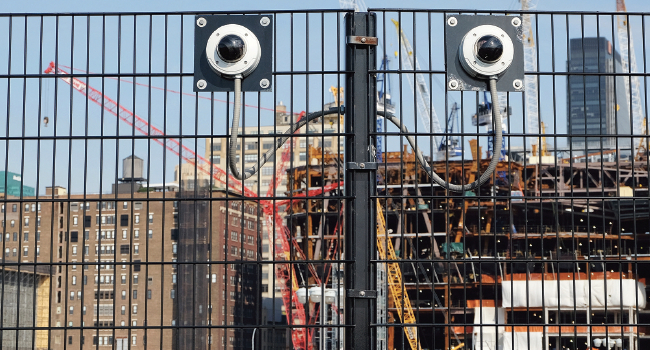
Guiding Principles
- By Brian Davidson, Andy Rudisill
- Feb 25, 2025
Construction sites represent a unique sector of perimeter security, especially amidst a steady increase in commercial construction. As in any security environment, assessing weaknesses and threats remains paramount and modern technology, coupled with sound access control principles, are critical in addressing vulnerabilities at even the most secure construction sites around the world.
The pillars of secure operational efficiency, which are detailed below, should serve as vital guideposts, not only at construction sites and in physical applications outside a facility, but within a building’s walls as well.
Despite commercial construction being a fundamental component of our society for hundreds of years, the marriage between it and advanced access control is a young one. Only within the past 10 to 12 years have companies started adopting more modern technologies and drifted away from manually checking in workers through a logbook.
The weaknesses in such an ecosystem are clear, including unauthorized access to sensitive areas, valuable downtime spent searching for people or assets, and the potential risk of equipment theft. Too often, companies do not realize the need for advanced security measures until it is too late, and an incident occurs.
Contractors need to have a comprehensive view of which workers are on-site and modern software systems are allowing them to monitor the workforce in real time. How that software communicates with physical access solutions like identification badges, gates and turnstiles, is a critical integration that more companies are starting to appreciate the value of.
At its core, it is a data-driven model that informs a variety of actions. If a contractor sees there are 10 workers badged into a drywall project and only three dedicated to wiring, they can reallocate resources to staff appropriately. If a worker has not badged in by a certain time, or if they are trying to access an area they should not, a notification is sent to a manager, which is particularly useful when overseeing many workers.
Should a threat arise, or a worker be terminated, an administrator can deactivate that person’s credentials immediately, limiting their access. A clear application for that would be in live construction areas, like educational or governmental campuses, where work is being conducted on or next to fully operational buildings.
Equally as important as the operational monitoring benefits of implementing comprehensive software solutions are the administrative benefits. There are a myriad of compliance regulations and reporting requirements regarding construction and staff.
Having software in place that tracks staffing and access can be a valuable supplement for managers who need to produce compliance reports, sometimes at a moment’s notice. Additionally, should an incident occur, managers can produce documentation for any legal actions, both proactive and reactive, including responding to any injury claims.
It is an efficiency tool that not only alleviates any inconvenience in the short-term but can also save companies time and money in the long-term by having clear auditing implemented from day one.
From the Outside Looking In
The signature of a hugely successful security system is in its level of integration and communication. As noted, the concepts detailed above can, and should be experienced not only at the construction site, but also inside a facility during normal operations as well.
The central asset for access control remains the key and, like personnel on construction sites, many companies are not aware of modern technologies that can help streamline their system-wide usage.
Intelligent key cabinets are a foundational element of access control management for a variety of industries, and they represent a transition from traditional storage solutions like a pegboard. Like in staff management, keys can be assigned different access levels and if an employee does not return one by a certain time, which can alert a manager, which speeds up tracking down that key.
If an employee is terminated, and their general access credentials are connected to the key cabinet, an administrator can deactivate access to both instantaneously. It is a streamlined approach that helps ensure efficiency and redundance, which are hallmarks of a sound security ecosystem.
In addition to improved workflow and strengthened access control, both personnel and key management measures represent a clear financial return on investment (ROI.) When you factor in downtime spent tracking down lost assets and tardy personnel, plus costs associated with having to re-hire new workers or re-key a facility, as well as any financial obligations related to legal actions stemming from an incident, the end monetary cost could be astronomical and negatively impact timelines and productivity goals.
There are a wide variety of solutions that claim to improve efficiency and security, but companies need to prioritize those that produce a clear short and long-term ROI.
Still, there are those who are hesitant to integrate such solutions, especially if they feel that legacy tactics and workflows are “how they’ve always done it.” To those that are willing to at least consider advanced technology, trying it out on a smaller scale is a prudent first step.
See how that technology impacts operations in a small sample size and then evaluate how that could improve efficiency on a larger scale. Managers need to have the full knowledge of how a solution will serve the workforce and, more importantly, be an advocate for its implementation.
If that directive comes from the top-down and incorporated at the start of any project or onboarding process, its adoption is more widely accepted. Two compelling examples of that can be seen in construction site and internal key management, which, in the most successful cases, are guided by comprehensive data management produced from strategic physical solutions.
This article originally appeared in the March / April 2025 issue of Security Today.